A reboot of the Chuck Norris epic series (1993-2001) and starring Jared Padalecki, who just finished up 15 years costarring in Supernatural, there are many fans of one or the other who are waiting for this one:
December 2020
Wed 23 Dec 2020
Tue 22 Dec 2020
An Archived Mystery Review by Doug Greene: GUY BOOTHBY – A Bid for Fortune.
Posted by Steve under Bibliographies, Lists & Checklists , Characters , Reviews[3] Comments
GUY BOOTHBY – A Bid for Fortune. Dr. Nikola #1. Appleton, hardcover, 1895. Published earlier in the UK by Ward Lock, hardcover, 1895. Reprinted as Enter Dr. Nikola. Newcastle, UK, paperback, 1975. Later reprinted by Oxford University Press, US, paperback, 1996; then many POD editions. Silent film: Unity-Super, 1917.
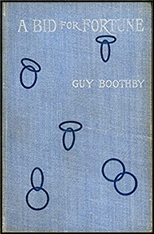
Searching for books is often a frustrating task, not merely because (as we all know) some books simply won’t be found but also because those that are located often turn out to be disappointments. In my experience, many highly touted classics have not lived up to their publicity. That is not the case, I’m glad to report, with Guy Boothby’s first novel about Dr. Nikola.
I leave it to others to discover whether Dr. Nikola is fiction’s first arch-criminal (is Moriarty in the same category?), but it seems likely that the Nikola books form the first sustained series featuring such a nefarious malefactor. A Bid for Fortune has coincidences galore and occasional purple prose (“Oh, my girlie! my poor little girlie! what have I brought you to through my. obstinacy?”), but it is generally well-told and well-plotted. Boothby keeps the reader interested not by overwhelming use of violence – indeed, I don’t recall a single murder in it – but by a sense of mystery.
The book opens with Dr. Nikola meeting 3 co-conspirators who plan, for an unnamed reason and by unspecified means, to ruin a man named Wetherell: “My toils are closing on you … you will find yourself being slowly but surely ground into powder. Then you may be sorry you thought fit to baulk Dr. Nikola.” The scene then shifts to Australia, to young Dick Hatteras who has made a fortune pearling and who plans to visit his ancestral home in England. He falls in love with Wetherell’s daughter, and on shipboard they pledge their troth (as they used to do; nowadays they just shack up).
Once in London, his fiancee is forced to 1eave him; he meets Dr. Nikola, and befriends a young nobleman whom he agrees to guide to Australia. The plot becomes steadily more complicated, as Nikola’s minions kidnap Hatteras and the young Lord in Cairo. Eventually, they return to Australia, and rescue all in distress, but Dr. Nikola obtains what he has sought from Wetherell. Nevertheless, the veil of mystery remains even in the final paragraph: “What gigantic coup [Nikola] intends to accomplish … is beyond my power to tell.”
Boothby, an Australian, had not only a sense of mystery but also a talent for description of 19th century England, Australia and Egypt. A Bid for Fortune is an excellent example of leisurely but engrossing fin de siecle storytelling.
The Dr. Nikola series —
A Bid for Fortune; or, Dr. Nikola’s Vendetta. Ward 1895.
Doctor Nikola. Ward 1896.
The Lust of Hate. Ward 1898.
Dr. Nikola’s Experiment. Hodder 1899.
Farewell Nikola. Ward 1901.
Tue 22 Dec 2020
Pulp PI Stories I’m Reading: T. T. FLYNN “The Deadly Orchid.â€
Posted by Steve under Bibliographies, Lists & Checklists , Characters , Pulp Fiction , Stories I'm Reading[15] Comments

T. T. FLYNN “The Deadly Orchid.†Trixie Meehan & Mike Harris #1. First published in Detective Fiction Weekly, April 15, 1933. Reprinted in The Pulps, edited by Tony Goldstone (Chelsea House, hardcover, 1970) and Hard-Boiled Dames, edited by Bernard Drew (St. Martin’s Press, hardcover, 1986).
I have written about the bickering pair of PI’s by the name of Trixie Meehan and Mike Harris before. You can find my review of “Barred Doors,†the seventh in the series, here. To recap quickly, though, they both work for the Blaine Agency and are always casting barbs at each other – in a friendly way, you know — or at least I think so.
In this, their first appearance, they go undercover in a plush hotel disguised as husband and wife (but in a suite of adjoining rooms, with a lock on the door between them). With the benefit of an unlimited expense account, they also are pretending to be a fabulously wealthy pair of Texans (oil money), and living it up greatly.
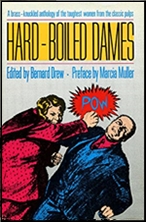
Their target: a incredulously beautiful wisp of a girl, nicknamed the Orchid, who is also a notorious blackmailer who has also been known to kill her victims when things don’t work out perfectly with one of her schemes.
Mike is the one who tells the story and the one who works up the plan to discover where the love letters she is holding over her latest victim are located, but Trixie is no slouch either when she is needed to take part in the action.
There’s not a lot of depth to the tale, but it’s smoothly told, in something of a screwball story sort of way. Somebody really ought to put together a complete collection of their adventures together.
The Mike Harris & Trixie Meehan stories –
The Deadly Orchid (ss) Detective Fiction Weekly Apr 15 1933
Falling Death (nv) Detective Fiction Weekly Oct 28 1933
Murder’s Masquerade (nv) Detective Fiction Weekly Mar 31 1934
The Yin Shee Dragon (na) Detective Fiction Weekly Sep 29 1934
Murder Harbor (nv) Detective Fiction Weekly Dec 1 1934
The City Hall Murders (na) Detective Fiction Weekly Mar 23 1935
Barred Doors (na) Detective Fiction Weekly May 18 1935
Nitro! Nitro! (na) Detective Fiction Weekly Apr 4 1936
The Letters and the Law (na) Detective Fiction Weekly Jun 27 1936
Abbey of the Damned (na) Detective Fiction Weekly Oct 30 1937
Murder Circus (na) Detective Fiction Weekly May 21 1938
The Secret of the Swamp (na) Detective Fiction Weekly Feb 25 1939
Brother Murder (na) Detective Fiction Weekly Dec 2 1939
Mike Finds Trouble (sl) Detective Fiction Weekly Aug 17 1940, etc.
Build Up for Murder (nv) Detective Fiction Aug 20 1941
Killer in the Clouds (ss) Detective Tales Mar 1951
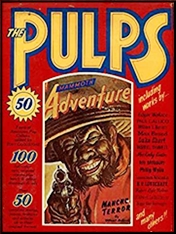
Mon 21 Dec 2020
A 1001 Midnights Review: BRIAN COFFEY – Surrounded.
Posted by Steve under 1001 Midnights , Reviews[4] Comments
by Bill Pronzini & George Kelley
BRIAN COFFEY – Surrounded. Mike Tucker #2. Bobbs-Merrill, hardcover, 1974. No paperback edition.
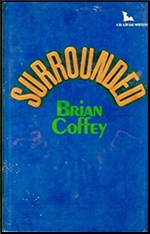
Brian Coffey is one of several pseudonyms used by prolific writer Dean R. Koontz. During the early 1970s, Koontz wrote a series of three caper novels featuring professional thief Mike Tucker – a more genteel version of Richard Stark’s Parker.
Tucker’s straight job is as an art dealer, but in order to live the wealthy life-style he’s accustomed to, he and various other professionals plan and execute occasional big-money heists. Tucker has his principles: He steals only from institutions – banks, insurance companies, department stores – whose losses are fully covered by insurance. And he is good enough so that after fourteen operations in three years, he has never failed.
Surrounded is the middle book in the series, and easily the best of the three. Tucker, along with two men, Frank Meyers and Edgar Bates, plan to rob the posh Oceanview Plaza shopping mall in southern California; the mall includes a bank. a jewelry store, and eighteen other business establishments. The plan is to hit the mall at night, get in and out as quickly as possible, and Tucker has it all worked out perfectly. Except for one thing – a vital. piece of information that Meyers, for reasons of his own, has withheld from Tucker.
The result is that an alarm is sounded during the robbery, the police arrive, and Tucker and the others are trapped inside the mall, completely surrounded, with no way out. In a clever variation on the classic locked-room gambit, they manage to hide themselves so that the police aren’t able to find them and assume they somehow must have escaped. (The reader isn’t told their hiding place until some time afterward, so that you may either match wits with Tucker or share the cops’ frustration.)
This is a well-written novel, ingenious and suspenseful. Tucker is no Parker when it comes to toughness, hut in the brotherhood of crooks he holds his own. His first caper, Blood Risk (1973), is also nicely done: It features another heist that goes sour, that of the biweekly take of a Mafia cell. Here, too, Tucker must improvise to save his own life and those of his partners. The last Tucker novel, The Wall of Masks (1975), is less successful: It has a convoluted and rather implausible plot involving Tucker’s specialty, art treasures (the Mayan variety), plus some strained humor.
———
Reprinted with permission from 1001 Midnights, edited by Bill Pronzini & Marcia Muller and published by The Battered Silicon Dispatch Box, 2007. Copyright © 1986, 2007 by the Pronzini-Muller Family Trust
Mon 21 Dec 2020
As heralded several weeks ago on this blog, audio of the previous “lost” series, Stay Tuned for Terror is now making its way across the web. It was a 15-minute show entirely written by Robert Bloch, with many of the episodes being adaptations of stories Bloch wrote for Weird Tales. You can find them here: Archive.org
Moreover, there are two articles that expand the history of the series including comments regarding the extant recordings. The first was published in the Old Time Radio Researchers periodical, The Old Radio Times
With the second posted on Dave Truesdale’s Science Fiction/Fantasy website: Stay Tuned for Terror
Mon 21 Dec 2020
A Movie Review by Jonathan Lewis: OLYMPUS HAS FALLEN (2013).
Posted by Steve under Action Adventure movies , Reviews[3] Comments
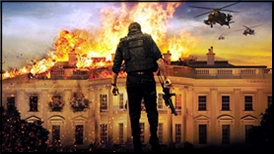
OLYMPUS HAS FALLEN. Millennium Films, 2013. Gerard Butler, Aaron Eckhart, Morgan Freeman, Angela Bassett, Robert Forster, Cole Hauser, Ashley Judd, Melissa Leo, Dylan McDermott, Radha Mitchell, Rick Yune. Directed by Antoine Fuqua. Available on Blu-ray and DVD and is streaming now on Netflix.
For the first hour or so, Olympus Has Fallen is a kinetic, exceptionally violent action movie that grabs your attention. It’s a barrage of gunfights and explosions, choreographed to near perfection by action auteur Antoine Fuqua (Training Day). With an exceptional cast – including the late Robert Forster who portrays a general tasked with responding to a major terrorist incident – the movie initially feels like a solid piece of cinematic escapism.
All that changes, however, by the third act. That’s when the viewer begins to recognize that what one is watching is essentially a Die Hard (1988) knock-off. But unlike Die Hard, this action flic is utterly bereft of character development, offbeat humor, and memorable one-liners. It’s all the carnage of Die Hard amped up to the max, but with none of the heart.
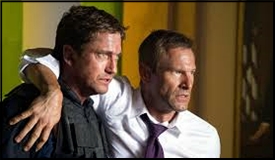
Gerald Butler portrays Mike Banning, a Secret Service agent tasked with saving the president from North Korean terrorists, Banning is no John McClane; he has no witty dialogue to speak of. Truth be told, he has no wit at all. Just brawn and a propensity toward cruelty toward his enemies. And while that holds the movie together for a while, it eventually wears thin.
The only character in the film who has any depth to speak of is Speaker of the House Alan Trumbull. This is largely due to the fact that he is portrayed by the always enjoyable Morgan Freeman, who imbues the role with necessary gravitas.
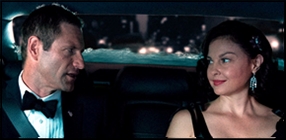
It’s not that Olympus Has Fallen is a bad movie; it’s just a rather empty one. A facsimile. Fuqua has done much better, particularly in his collaborative efforts with Denzel Washington. What went wrong here? I suspect it was the screenplay. Or the reliance on audiences not noticing how very derivative it all is. That said, the movie fared well at the box office and did spawn two sequels. Make of that what you will.
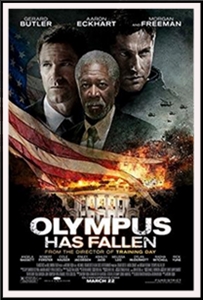
Sun 20 Dec 2020
An Archived Review by Bob Adey: BEN BENSON – Beware the Pale Horse.
Posted by Steve under Reviews[4] Comments
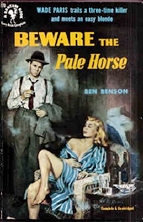
BEN BENSON – Beware the Pale Horse. Captain Wade Paris #2. M. S. Mill, hardcover, 1951. Bantam #1070, paperback, 1953. Wildside Press, trade paperback, 2018.
Competent, well clued and thought out police procedural starring State Detective Wade Paris. Paris’s difficulties stem not only from trying to find out who killed both a police colleague and oriental art collector, Charles Endicott, but also from the political pressures that are put upon him to wrap things up quickly and successfully.
This political angle is brought in most convincingly and the investigation itself is logical and systematic. The clues are spread with care and cunning and the main one I should have spotted deceived me. Short on humour, but otherwise I can find nothing to complain of in this very professional job.
A pity (from my point of view) as it’s the first I’ve read of half a dozen Bensons I own, and I was looking for an excuse to make a small reduction in the overcrowding on my shelves. Now I’ll be looking for even more Bensons!
Sun 20 Dec 2020
OTR News from Karl Schadow: THE AVENGER Radio Show.
Posted by Steve under Old Time Radio[5] Comments
There is great news for fans of THE AVENGER. A 1941 episode of the WHN production featuring Richard Henry Benson has now been posted online:
While this particular exploit has been on collectors’ shelves for years, it has not been widely circulated nor publicized. This rendition is from the earlier series that is much different than the Brandon version (a takeoff of The Shadow) which is most familiar to listeners. The WHN program is more loyal to the characters in the pulps.
The YouTube presentation includes brief historical notes on both the Benson and Brandon series. The video was designed to stimulate interest in THE AVENGER and the BLOOD ‘N’ THUNDER journal.
Sun 20 Dec 2020
An Archived “Impossible Crime” Mystery Review: BARBARA D’AMATO – The Hands of Healing Murder.
Posted by Steve under Reviews[3] Comments
BARBARA D’AMATO – The Hands of Healing Murder. Charter, paperback original, 1980.

For a first novel, and a paperback original at that, this book turns out to have a surprising number of things going for it. It also succeeds in going against the current flow of action/suspense/horror fiction in being a decently presented work of detective fiction. (Note the emphasis.)
The detective is Dr. Gerritt DeGraaf, a pathologist who happens to be there at the scene of the first murder. He also happens to be a close friend of Inspector Craddock, and this allows him to channel his bubbling enthusiasm for life and the challenge of the impossible into solving the case as well.
The victim dies in a room where eight other people are playing duplicate bridge, although not in full view of any of them. The fingerprints on the murder weapon belong to none of them, however, and as it happens, no one else could have entered the room. In short, the impossible has happened.
Some interesting discussion of the technology of fingerprints eventually takes place. A question of morality also comes up – that which underlies the constant pr0blem faced by doctors whenever they must decide who it is who lives and who will die in the confrontation of both limited time and limited resources.
The story is obviously intelligently written, if not always imaginatively. It is Craddock who tells the story, and sometimes this is awkward, as there are parts of it which he can tell only as hearsay. It is also not quite clear when DeGraaf has the solution, and the hint of late-blooming romance (storywise) seems oddly out of place.
Overall, however, a cozy, comfortable sort of detective story, which, coincidentally enough, I was exactly in the mood for when I read it. It’s certainly an above average debut, and one definitely not to be missed if Agatha Christie, for example, is your idea of a perfect “10.”
Rating: B plus.
UPDATE: There was to be only one more case to be solved by Dr. DeGraaf, that being The Eyes on Utopia Murders (Charter, 1981). Most of Barbara D’Amato’s mystery fiction came in the form of her Cat Marsala series, she being an investigative reporter based in Chicago, of which there were eight novels and one short story.
Sun 20 Dec 2020
Pulp Stories I’m Reading: ROBERT R. MILL “Murder on the Island.â€
Posted by Steve under Pulp Fiction , Stories I'm Reading[11] Comments
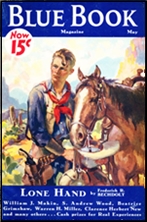
ROBERT R. MILL “Murder on the Island.†Short story. “Tiny†David #1. [Corrected to #2. See Comment #1.] First published in Blue Book, May 1933. Collected in Murder on the Island and Other Stories of “Tiny†David and the Black Horse Troop (Black Dog Books, paperback, 2004).
We don’t get to see any of the Black Horse Troop in this, the first story of 47 in all, all appearing in Blue Book magazine between 1933 and 1942. The Black Dog collection contains only four of them. The rest I imagine I’ll never get a chance to read, never having collected the magazine, and the ones I did own for a while are long gone.
In this one, we meet only Trooper Edward David and his immediate superior, Sergeant James Crosby. The setting is somewhere in the Adirondacks in New York State, as Tiny and the sergeant are rowing to an isolated island where a wealthy man and his daughter are living, along with several servants. Disliking publicity, visitors are generally not welcome, but an urgent telephone call from Joseph Bahn has them heading that way in rowboat, and in a hurry.
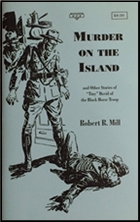
Once there they find the body of the Bahns’ butler, dead, having been shot in the head. Although six foot two and weighing 220 pounds, “Tiny†David may appear lazy and slow-witted, but he’s one observant fellow, a lot sharper than his sergeant, and when he senses that something is wrong with the scenario they’ve been presented with, you can count on his sense been exactly right.
What this story turns out to be is a perfectly ordinary detective mystery, a rather light-hearted approach that even without a challenge to the reader, an equally observant reader can see and interpret the same clues that Tiny does.
For more on the author and the series, here’s a link to Sai Shankar’s Pulpflakes blog and his essay on both:
https://pulpflakes.blogspot.com/2017/01/robert-r-mill.html